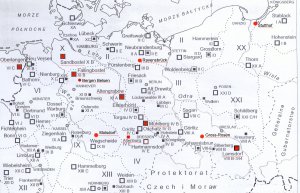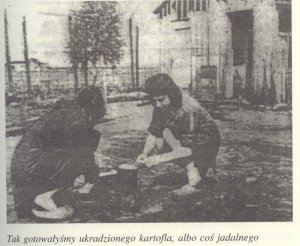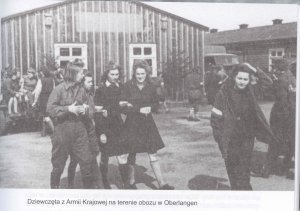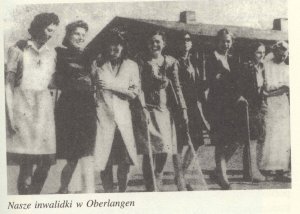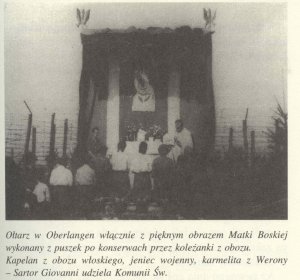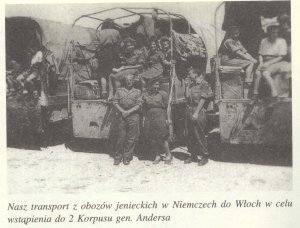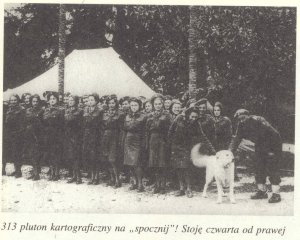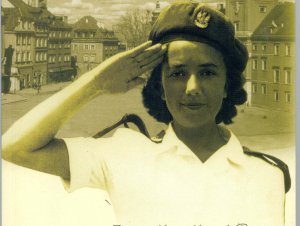After the outbreak of the war in October 1939 the Chief Command of the Polish Victory Service (Służba Zwycięstwu Polski) founded the auxiliary Women’s Service (Służba Kobiet). At the beginning of 1940 the commander in chief of the Union for Armed Struggle (Związek Walki Zbrojnej) Col. Stefan Rowecki “Grot” (“Arrowhead”) stated that women did the same service as the men, and so he called into being the Military Women Service. This was confirmed by the decree of 27 October 1943 issued by the Polish president-in-exile in which the rights of men and women were regarded as the same; this in turn paved the way for the practice of conferring military ranks to women.
Women made up to 10% of the personnel of the Home Army. They constituted part of almost all underground organizational units. They would organize the liaison units that were based on couriers and liaison officers and take part in the circulation of the underground press and underground publications of the Home Army. Women were the only members of the “Dysk” (Discus) – a Sabotage and Diversion unit. Women would also form Women Mining Patrols that would frequently take part in the Operation “Wieniec” (Wreath) whose task it was to blow up railway connections around Warsaw. In countryside women were either employed in medical service that supported guerrilla troops or they rendered service for the logistics.
When the Warsaw Rising broke out, about 5000 women-soldiers of the Home Army served as either liaison officers or nurses. In a special platoon of the sewer liaison they constituted up to 60% of its personnel. They worked in the sections that specialized in sabotage, information and propaganda as well as logistics.
In the first weeks of the Rising, the Polish prisoners-of-war were regarded by the Germans as criminals; if they were spared their lives, they were either sent to concentration camps or to forced labour in the Reich. The fate of these men was shared by the women. Many of the nurses that remained with the heavily wounded insurgents in such parts of Warsaw as Wola, Stare Miasto, Powiśle and Czerniaków were murdered by the brutal soldierly. Other women-soldiers were sent to concentration camps of Stutthof, Ravensbrück and Gross Rosen.
Due to the political pressure of the Western Allies Germans ultimately recognized the insurgents as military service men and began to treat them accordingly. However, even then a number of atrocities against the Polish prisoners-of-war were done.
On 20 September 1944 the insurgent units were transformed into a regular Home Army Corps that comprised three divisions:
- 8 Infantry Division of the Home Army, named after Romuald Traugutt, consisting of: 13 Infantry Regiment, 21 “Warsaw Children” Regiment and 32 Infantry Regiment;
- 10 Infantry Division of the Home Army, named after Stefan Okrzeja, consisting of: 28 Infantry Regiment, 29 Infantry Regiment and 30 Infantry Regiment;
- 28 Infantry Division of the Home Army, named after Maciej Rataj, consisting of: 15 Infantry Regiment, 36 Regiment of the Academic League, and 72 Infantry Regiment.
On October 2, 1944, signing the capitulation treaty the Germans granted the combatant rights to the insurgents. At the same time, however, they were bound by Himmler’s directive of 8.09.1944 sent to General von dem Bach in which it was demanded that prisoners of war be sent to concentration camps. Even when the prisoners were sent to Oflags or Stalags the conditions there were such as in the concentration camps.
On the grounds of the capitulation treaty about 3000 women – soldiers of the Home Army that participated in the Warsaw Rising - were taken prisoners of war, which phenomenon was unparalleled in the history of World War Two. Commencing from October 6, 1944, other groups of women would be sent to different prisoner-of-war camps.
Wounded and sick, they were all transported to the camp hospital in Zeithein, which was a branch of the large Mühlber - Stalag IV B Camp, located between Dresden and Leipzig. Towards the end of November part of the women was transported to other prisoner of war camps. On 23 April 1945 Zeithein was liberated by the Soviet Troops. In June the same year some of the women, together with their French and Italian companions, wended their way to the American Occupation Zone; others came back to Poland.
The women members of the General Command of the Home Army and members of the 15th and 21st infantry regiments were transported to Stalag 344 in Lamsdorf; later on they were moved to Stalag IV B Mühlberg on the Elbe. After a three-week period the women holding the officer’s rank were grouped separately. From among the women-soldiers 237 of them were sent to work in the armoury in Chemnitz, which was in breach of Article 31 of the Geneva Conference. After the armoury had been bombed by the allied air forces in mid March 1945, the women were moved in two groups to Stalag VI C in Oberlangen, close to the border with the Netherlands. Those officers and women who refused to work in the labour units were transported to Stalag IV F Altenburg, Hartmannsdorf. The women officers were later moved to Molsdorf Oflag.
The women serving for the 72nd infantry regiment were transported to Stalag X B Sandbostel in the vicinity of Hamburg. They numbered about 500 persons, of which 90 were officers. In December 1944 a group of women officers formed a separate group that was sent to Molsdorf. A group of non-commissioned officers together with rank-and-file soldiers was sent to Oberlangen in the period between December 1944 and February 1945.
The group serving for the 21st infantry regiment was transported to Stalag XI A Gross Lübars, Altengrabow. 240 member of this group were in good health, 160 were ill or wounded that were taken care of in hospital. The healthy prisoners of war were gradually sent to work at the armouries. When the attempts to convince them that they should renounce the rights of prisoners of war failed, they were in mid December transported again to Gross Lübars, and then in groups to Oberlangen.
The fourth group of women were those that served for the 36th infantry regiment and the Corps Command. On 11 October a group of 475 women was sent to Stalag XI B Fallingbostel in the vicinity of Hanover. After a few days 90 commissioned officers and 9 adjutants were transported to the Bergen-Belsen concentration camp near Hanover, where part of this camp was arranged as an Oflag. Some 374 women remained in Fallinbostel, among them 16 clandestine officers, acting in the dealings with the German authorities in the rank of a staff sergeant, and performing a previously issued order of the Home Army Command that obliged them to take care of the younger women-soldiers in the official capacity as their prisoner companions. The women from Bergen-Belsen, just as the women in other camps, were sent to forced labour such as removing debris from the railway tracks and work in the armouries. Here, too, they were pressed to resign from their rights as prisoners of war. In December 1944 the women-officers were sent to Molsdorf, the rank-and-file soldiers to Oberlangen.
In all, some 500 women were transported to Molsdorf from the camps in Fallingbostel, Bergen-Belsen, Gross Rosen, Altenburg, Lamsdorf and Sandbostel. Stalag VI C in Oberlangen for the Home Army women soldiers was formed as a result of the fusion of Stalags IV B, IV F, X B, XI A, XI B (Altenburg, Sandbostel, Gross Lübars, Fallingbostel and others). There were 1,736 women altogether, among them 94 were at the age of less than 18 years old and 14 were children brought here together with their mothers. 52 of them were commissioned officers who did not reveal to the German authorities their actual rank, and some 510 non-commissioned officers.
Oflag IX C Molsdorf.
Oflag IX C Molsdorf was created after the fall of the Warsaw Rising. It was a small camp, capable of accommodating 400 people, and it was a branch of the Buchenwald concentration camp intended for the prisoners that were engaged in building the motorway. The camp was located on the bottom of a dried lake, in a swampy dale, covered in thick, greasy slough. The camp was made up of seven old rickety barracks surrounded by a network of barbed wire. The buildings accommodating the German command as well as the passages linking them were raised on piles. The camp in the shape of a small rectangle was situated south of Molsdorf, close to the Erfurt-Ichtershausen country road.The status of the officer prisoners of war consisted in that they were not sent to forced labour in the German armouries; they had also the privilege of having their batmen with them in the ratio of one batman to ten officers. In Molsdorf Oflag there were some 380 women officers, 38 rank-and-file batmen and 3 children. Assuming that the conditions on the Oflags would be better than those in the Stalags (i.e. camps intended for the rank-and-file soldiers), it was during the Warsaw Rising that the Headquarters of the Military Women Service envisaged that orderlies in the women prisoner of war camps would be recruited from the youngest and the weakest women volunteers as well as from the members of the officer families for the purpose of creating for them the conditions for care, protection and mutual company.
Major Wanda Gerz a.k.a. “Kazik” was the Polish commandant of the camp. In the underground she was the commander of the sabotage unit “Discus”, which was subordinated directly to the Directorate of Sabotage and Diversion (Kedyw). She took part in numerous military actions, for which she was decorated with the Order of Virtuti Militari V Class and with the Cross of Valour; she was conferred the latter decoration five times.
The second in command was Major Janina Krasiówna "HaKa", one of the co-founders of the Service for Poland's Victory. During the time of the occupation she formed a network of underground liaison throughout Europe. She was decorated with the Order of Virtuti Militari V Class and with the Cross of Valour. The other second in command was Major AK Maria Szymkiewicz "Rysia", Military Training of Women instructor, decorated with the Cross of Valour.
Captain Helena Nieć "Helena” was a delegate. Prior to this she was a clerk of the Women’s Military Service, 7th District Warszawa, Poviat "Obroża". She had a perfect command of English, French and German. Her duties included maintaining contacts with the German command of the camp, relaying the complaints, requests and communiqués to the Red Cross. The latter usually did not reach Geneva, being filtered in the Oberkommando der Wehrmacht.
The living conditions in the camp were very hard. The barracks that were put up in the years 1938/1939 for the workers building the motorway were old, rickety and partly burnt. It was freezing cold inside them. The walls were damp, with the very limited access of the sun heat to them. Only the ward accommodating the sick was heated; otherwise, the temperature in the barracks would fell to minus 17 degrees Celsius. The lack of heating and the meagre food were two detrimental factors. After a time parcels from home were allowed into the camp. They usually contained peas, beans, cereals and flour. There were, however, no facilities for cooking. The women would try making primitive cookers from cans, fuelling the fire by means of burning paper or small pieces of wood or cardboard. The German Commander of the Bad Sulza Camp, who had authority over Molsdorf as well, forbade the use of the primitive cookers and he didn’t allow any supply of fire-wood.
The camp was infested with mice and rats which, for want of other food, devoured clothes. Bedbugs were also a problem. Here was never hot or even warm water in the bathroom. The hygienic conditions were extremely primitive. Due to the high humidity, washed clothes had to be dried for weeks. To shorten that time, women would put on their bodies the wet clothes or lie on them in their bunks. The Red Cross parcels would not reach their destinations, being lost somewhere on the way.
There were four doctors on the camp. The ward for the sick was not much different from other rooms. It was heated a little and there were ordinary beds rather than bunks placed one over the other. There were no utensils for the water to be boiled and the medical instruments were few and far between. The health of the prisoners due to the conditions was very bad. Daily up to 120 women were reported to be sick; some of the sick women had to lie on their bunks, since the ward for the sick was filled to capacity. The commonest diseases included nephritis, pneumonia, and bronchitis.
Despite the bad conditions the women prisoners would not give in. Self-study classes would be organized and lectures on various topics given. An actor troupe that gave several plays was also brought into being. The prisoner actresses would put words of the plays down on paper from memory so as to have the official approval (the "Geprüft" seal on the text) from the command of the camp; these texts would later be memorised by amateurs, who were more than willing to take part in the drama classes. The plays included ‘The Wedding’ by Wyspiański, ‘The Little Quail’ by Żeromski, the ballad about ‘Janosik and Countess Szalamonówna Jadwiga’ by Przerwa-Tetmajer. Wonderful dresses were created out of nothing for the plays. For lack of any musical instruments, the music background was provided by the choir voices, frequently without lyrics.
The camp library consisted of a mere 105 books, mostly brought here in rucksacks from Warsaw. The women prisoners asked for books in Polish, English, French, and German as well as for books and dictionaries from which they might learn the foreign languages. They were interested in psychology, sociology, natural sciences, medicine, history and pedagogy. They had little if any paper, stationery, decorative materials, games; they wished they had at least one accordion. They were deprived of any possibility of professing their religious faith; there were no religious services held in the camp.
The Molsdorf Camp was formally subordinated to the Wehrmacht; the camp’s commander was a Wehrmacht captain. Once the camp was inspected by the SS-troopers from the Buchenwald Camp, whose branch was Molsdrof. The prisoners were searched from head to foot, standing in snow, by the German women using the methods they would apply in the concentration camps. When one of the prisoner women protested against having a photo of her husband taken away from her, she was hit by the German woman so hard on the face that she fell to the ground. The tough resistance of the Polish commanders of the camp, including the delegate ‘Helena’ forced the Germans to give up the inspection and to return the confiscated things to their owners.
On February 6, 1945, an air fight between two allied and one German aircraft took place overhead. A series of bullets form the fighters ripped some of the barracks roofs. One of the women officers, Lieutenant “Żaczek” had her belly and spinal cord hit by several bullets. As a result of it she died; there a further sixteen casualties. Having learnt that the death was caused by the bullets from the allied combat aircraft, the Germans started a spectacular rescue operation. Ambulances were called in and together with them the German newsreel operators and journalists, whose task it was to document the brutality of the allied forces that do not spare even their own comrades in arms.
Heavily wounded, hand carried by the German doctors and nurses, the women were brought to an Arnstadt hospital, where they were all placed not in the hospital wards but in an empty house that was deprived of beds, which fact was not shown by the newsreel. Those who had minor injuries were left to the care of the camp women doctors in the sick ward. The Germans returned the medicaments that had been previously confiscated from the camp.
The funeral of Lieutenant “Żaczek” was celebrated with all military ritual. The Germans made a show of how the gallant German officers treat the enemy prisoner of war upon his death. A troop of soldiers brought a large wreath with a sash that bore the inscription “"Deutsche Wehrmacht". The Italian prisoners that served in the German command of the camp brought a wreath with the inscription "Eviva Polonia - Eviva Italia". The Polish women were allowed to buy floral tributes with their own money, which was later refunded by the Germans. Even a priest was brought in. No one knew who he was; no one was allowed to have a word with him. He stood in the corner of the hall, turned towards the wall; then he led the funeral procession, said a prayer in Latin. Then he was immediately taken away by the same convoy. The German soldiers made a fire salute at the moment when the body was being lowered into the grave.
In the beginning of April the women prisoners were taken out of Molsdrof Oflag and led westwards. Thirty sick women were left behind and placed in the anti-aircraft bunker that was previously intended for the Germans. On 8th of April the American soldiers of the party of the 89th infantry division of the 3rd American army commanded by General Patton reached the camp and went carefully inside the bunker. They were amazed to see the several women lying on the floor one by another. Upon further investigation they learnt that they were prisoners of war from Warsaw, and that they were in need of an immediate help for one of them who had been suffering labour pains for the previous three days. The soldiers immediately passed the information to the command and shared their combat food rations with them. They also asked the women how they had been treated by the German guard; they suggested executing the guard on the spot in case his behaviour towards the women was unsatisfactory. The women did not accuse him, though. All the sick women were taken on the trucks to an Erfurt hospital to join their pregnant companion, who was transported there earlier. The application of penicillin saved her life, but her child could not be saved. The terrain where the women-prisoners were found was to be handed over to the Soviet occupation forces, which was in accordance with the diplomatic agreements. In the light of this the Americans, before they evacuated their troops from this terrain, sent all the Polish women in a sanitary convoy to Burg, Hessen, the place where all liberated Home Army women soldiers from the Warsaw Uprising were being grouped. They reached the said destination on May 8th, 1945.
The main group that left the camp on 5.04.1945 covered a thirty-five-kilometre distance to Blankheim on foot, where they were given accommodation in the former HitlerJugend training centre. There they were liberated by the Canadian forces that were part of the 3rd army of General Patton. These units not knowing that the buildings accommodated Polish prisoners of war, opened fire on them. Major “Kazik” sent towards them some envoys who knew the English language well. The event took place on 13th of April. The crew of the camp laid down their arms, and the German captain handed his gun and belt to Major Wanda Gerz “Kazik”. Before long the Polish women were set free. In a few days they would be reunited with their camp companions in Burg.
Stalag VI C Oberlangen.
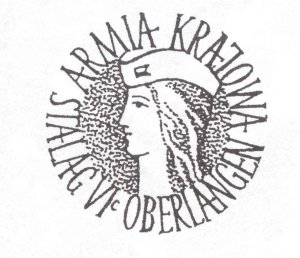
The emblem of the women society of Oberlangen
Penal camp Strafflager VI C Oberlangen had a very ‘bleak’ past. Situated on the swampy ground of Emsland in the north-western part of Germany, close to the border with the Netherlands, it was one of the many concentration camps founded in the years 1933-1938 for the opponents of the Hitler’s regime. During World War Two it was taken over by the Wehrmacht; on its premises a camp for the prisoners of war from the occupied countries of Europe was founded. Unfavourable climate conditions, starvation and disease caused most of the prisoners to die.
In October 0f 1944 Strafflager VI C Oberlangen was crossed out from the list of the prisoner-of-war camps because its living conditions were beyond any acceptable standards. The International Red Cross did not realise that it was the place where the Polish women prisoners of war were transported. The Germans treated the Oberlangen Camp as a camp suited for the prisoners of war and so they sent there those Home Army women soldiers whom they regarded as subversive and rebellious individuals that would not resign from their rights due to the military combatants and work in the German armoury.
Oberlangen accommodated 1.721 women altogether from the Warsaw Rising. They were at the age of between 14 and 60. Among them there was a group of distinguished Women’s Military Service instructors who, in accordance with the decisions taken during the time of the Warsaw Rising, concealed their officer military ranks so as to be placed together with the women soldiers in the Stalags. Their task was to train the hundreds of young women who were not accustomed to the military discipline to form a military group.
Among the women – participants of the Warsaw Rising – in Oberlangen there were 94 girls at the age of 18 and less as well as 14 children brought to the camp together with their mothers. There were also 52 officer women who concealed their actual ranks. Captain Maria Irena Milska "Jaga", acting as a sergeant, was the camp’s commander. She was a respected and liked by everyone.
The German command was made up of four persons: Colonel SS Miller, soon to be replaced by Captain Mehler, quartermaster Lieutenant Teiber (a rude and vicious personality), Staff Sergeant Majchrzak and Corporal Zwieklick (also called by the Poles Glow-worm). There were also three German women, who often carried out inspections, ransacking and controls. The camp was guarded by 80 soldiers.
Commander “Jaga” would rule the camp with an iron hand. It took the knowledge of psychology and a measure of perseverance to maintain discipline among the women of various social backgrounds, of various ages and professions. “Jaga” singled out a competent staff that was to help her in the task. The commanders of particular companies (one barrack meant one company) had also concealed their actual military ranks as commissioned officers for the purpose of extending their care to the rank-and-file women in the camp. It was a necessary requirement, especially towards the underage women and those who would easily break down succumbing to the barbed-wire syndrome.
The living conditions in which the women prisoners were to survive winter were among the hardest. Rickety wooden barracks with non-hermetic windows and doors, the rooms accommodating 200 women with bunks placed one over the other, thin mattresses filled with hay, two iron stoves per barrack fuelled with peat that gave smoke rather than heat; a row of metal troughs in one of the barracks with a thin stream of water and a few simple latrines made up the whole of the sanitary facilities.
The healthy women lived in the eight barracks in the camp, whereas the hospital barrack, the kitchen, the sewing room, the bathroom and the disinfections room (the latter two were rather out of use) were all located in the premises adjacent to the camp. One of the empty barracks served as a chapel, two others (not accommodated by women) were turned into a depot for fire-wood. The fire-wood for the stoves derived from the wood of the bunks, floors and window frames, which caused the German authorities of the camp to impose reprisals for, as they termed it, the “destruction of state property.”
The nourishment, like in other camps, was very meagre. The morning and evening meals were made up of lukewarm herbal teas, moulded bead, sometimes a piece of margarine or a spoon of beetroot marmalade. The midday meal was made up of bitter kale soup or pea soup (the pea was infested with worms) plus two or three jacket potatoes. The Red Cross parcels were coming in very small numbers from the other camps; they were often stolen by the Germans or withheld for several days at the Lathen railway station, 12 km away from the camp. The Red Cross in Geneva did not even know that the camp in Oberlangen had been reactivated.
Despite all these hardships the Polish organisation inside the camp worked perfectly well. The camp inmates stuck to the principles of discipline, solidarity and friendship. When in January the first babies were to be born (some of the women had been pregnant at the time when they were deported from Warsaw), Commander “Jaga” said at the camp assembly: “A baby is about to be born: it is going to be naked, for its mother has nothing.” That appeal was enough. Each woman who had anything to spare – a blouse, a shirt, a scarf, a piece of bed clothes – would get down to the work of sewing, ripping and washing. The number of the diapers, clothes and caps for the first baby was so large that is sufficed for all the other babies that were yet to be born. Even the cardboard from the Red Cross parcels would be turned into cradles. Thus 10 babies were born in Oberlangen.
Every day teams of workers would leave the camp to do forced labour: they would gather brushwood, peat from the peat bogs as well as disposing of the sewage from the latrines. The spare time would be devoted to self-study, leisure activities and the learning of military instructions. The presence of many talented and educated women resulted in many lectures and art classes that were held in the camp. By means of pen-knives that were smuggled into the camp despite the many inspections, or by means of nails that were pulled out of the bunks some of the women would make such artefacts as cups, lockets, and pictures using tins, pieces of clothing or straw.
There was no chaplain that would be present in the camp on a permanent basis. After much insistence the Germans eventually allowed an Italian priest from a nearby Italian prisoner-of-war camp into Oberlangen to say the holy mass there. For obvious reasons an Italian priest could not hear confessions nor comfort the needy. At the request of Commander Lieutenant “Zbigniewa” and the qualified nurse “Maryla” they were sworn in by the Italian priest as camp trustees. It is due to their initiative that the so-called ‘question box’ came into being; the box was to collect and deal with the questions and problems that were too personal to be made known to everyone, which, however, demanded attention to prevent some of the inmates from breaking down and discourage some of them from thoughts of suicide.
One day Oberlangen was visited by a certain German officer who was introduced to the inmates as a close friend of Hitler’s. His task, which he tried to implement for three days, was to convince the Commander “Jaga” of Hitler’s friendly attitude towards Poland and towards the Warsaw insurgents in particular. He aimed at creating a legion of Polish women that would fight against the Red Army. The Polish camp authorities advised him to address his proposal to the commander-in-chief of the Home Army, General Bór Komorowski, who was also a prisoner of war somewhere in the Reich.
When this attempt of Hitler’s friend failed, there came another delegation of German officers whose task it was to extract from the camp Polish commander a declaration that the Geneva Convention concerning the prisoners of war was observed in the Oberlangen. The German delegation was headed by the chief of the network of camps in this region of Germany. The delegation wanted to induce the Polish camp authorities to withdraw the report that had been sent to Geneva in which the women complained about the inappropriate behaviour of Lieutenant Treiber toward Commander “Jaga”. Lieutenant Treiber had said to her that he held the Geneva Convention for nothing and as proof of that he aimed his gun at her and fired – fortunately missing.
The debacle of Germany was closer and closer and the end of war loomed near. At the beginning of April, 1945, the Polish 2nd anti-tank regiment of the 1st Armour Division commanded by general Maczek had crossed the Mose on the border between the Netherlands and Germany, in the vicinity of Ter Apel. The regiment’s commander Lieutenant Colonel Koszutski received information that at a distance of 10km there was a heavily guarded camp with Polish prisoners of war or political prisoners. Lieutenant Colonel Koszutski faced an alternative: either to allow the Germans to liquidate the camp together with its inmates, which often happened in those days, or, in breach of the orders that he had received, to move his unit further on, beyond Ter Apel. The breach of order might have exposed his own soldiers to a great risk. The commander decided to scout the vicinity of the camp on his own. To this end he created a small patrol-group made up of one tank, two scout cars, one jeep, and one motorcycle. The crew of them all consisted of 12 men, among them 6 officers and a war correspondent.
The patrol group set out on 12th April at 14 hours. Beyond Ter Apel it was German territory. The Polish soldiers moved on with care. They were shot at from a nearby grove; the Polish troops shot back. Beyond the grove they saw vast lowlands and towards the horizon some buildings and watchtowers so peculiar to German camps. Lieutenant Colonel Koszutski ordered one of the scout cars to move to the other side of the camp, and one to remain in the rear as cover for the operation. The tank was to slowly move along the barbed wire just to make an impression. When the commander saw a break in the wire network and a large wooden gate, he gave the order for the tank to ram the gate. The tank moved forward and got inside the camp, with the remains of the gate and the barbed wire trailing behind.
To the left of the watchtower another watchtower came into view; the tank’s machine gun shot at it which caused the twelve Germans to come out with their hands raised in the sign of surrender. From the building opposite the watchtower someone opened fire from a machine gun, which met with the reply of the tank’s machine gun that was manned by the radio operator. Before long a German major with a sergeant came out. He laid down his arms and said: “I’m surrendering the camp. We’re soldiers, not the Gestapo. I request appropriate treatment of us.”
The Polish armour patrol came to the edge of the rectangle of the barracks. All of a sudden a small human figure came running towards the soldiers. It wears a long military coat, which almost touches the ground. Its head is surmounted with a Polish forage-cap fitted with the Polish national emblem and the pennant symbolising the 7th Uhlan Regiment. The figure turned out to be a young, pretty girl. She shouts: “"English, Francais, Amerikano, Kanada, sind Sie?". “We’re Polish, we’re Polish, miss! The armour division,” answers her one of the soldiers.
From the barracks as if from bee-hives streams of women come running. They wear uniforms, though tattered and shabby. The crowd is full of joy, shedding tears, waving hands, laughing. A woman wearing the rank of the liaison captain wends her way through the crowd. Upon reaching Lieutenant Colonel Koszutski, she introduces herself as Mileska, the Polish commander of the prisoner-of-war camp for women in Oberlangen. Lieutenant Colonel Koszutski wants to evacuate the camp immediately, fearing a German counter attack. “Jaga” objects to it, since the women are not yet ready for a march; some of them are sick, others have babies to take care of. Still the liberated women are joyful.
The camp’s commander assembles the women; they quickly form a rectangle formation that transforms the crowd into a military unit. One can recognise in them the soldiers who fought on the barricades and on the debris of their houses; in the streets of their capital city, opposing tanks and aircraft, almost armless, not even protected by the Geneva convention that imposes it on the warring sides to respect prisoners of war and the wounded, be they men or women.
An order is issued: “Barracks – report!” One by one commanders of particular barracks come up to the camp commander and give accounts. The adjutant takes the accounts down on paper. An order is issued: “Battalion – attention! Eyes – right! Sir, the women battalion from the defence of Warsaw stands at your disposal. 1.716 soldiers present, 20 in the hospital barrack plus 7 babies. Battalion – attention!”
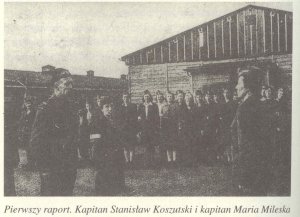
Reporting in the liberated camp
Lieutenant Colonel Koszutski walks in front of the rows of women soldiers. He can but hardly control his emotions. This is the moment of liberation, longed for by the inmates for six months.
Standing in front of the soldiers, he says” “Soldiers of the Home Army and Sisters-in-arms! This is a historic moment of the meeting of the two kinds of the Polish Armed Forces on German soil… may this twelfth day of April remain forever in our memories as the crowning of all the longings and hardships. You are free now. Long live Poland!”
The camp’s adjutant produces from her pocket a memorable piece of cloth, which the Italian priest hoists on top of a mast. The white-and-red flag flutters in the wind. The soldiers start singing “Poland has not yet perished".
After a time the Oberlangen women were moved to the place where other former Polish prisoners of war were accommodated.
Epilogue
The post-war fate of the women soldiers was similar to that of their brothers-in-arms.
Some women decided to come back to their country, where for many years, as the Home Army soldiers, they were disrespected by the communist regime. Others chose to emigrate, settling down in Great Britain, the United States, Canada or other parts of the world.
None of them ever forgot the most important thing: they all remained Polish patriots.
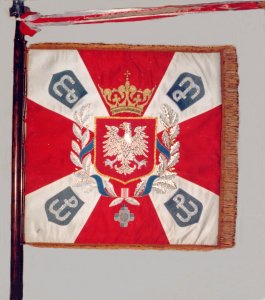
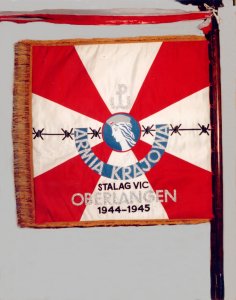
The Standard of the Oberlangen Society
Copyright © 2006 Maciej Janaszek-Seydlitz. All rights reserved.
